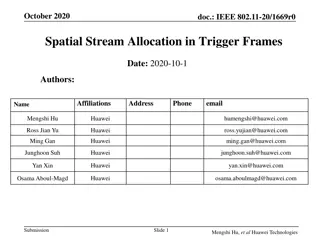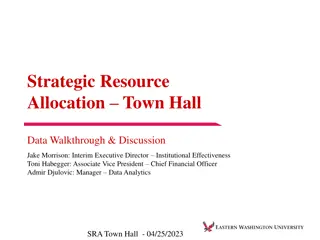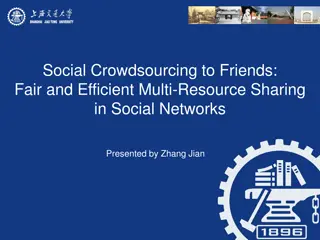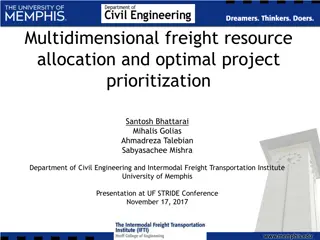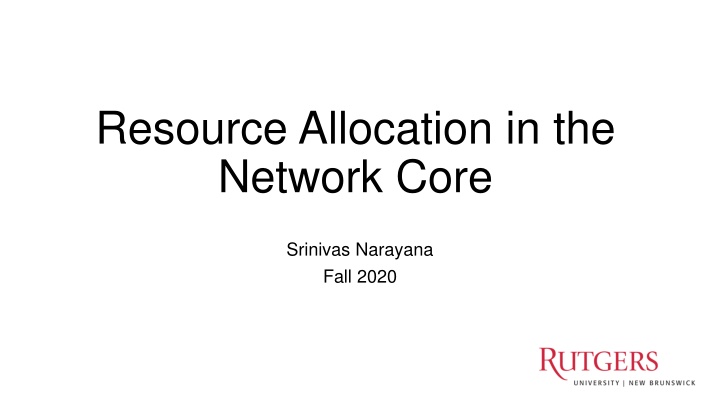
Network Core Resource Allocation Strategies
Explore the challenges of resource allocation in the network core, from the use of distributed algorithms to packet scheduling and queue management. Learn how endpoint behaviors and network design influence performance and reliability in data transmission.
Download Presentation

Please find below an Image/Link to download the presentation.
The content on the website is provided AS IS for your information and personal use only. It may not be sold, licensed, or shared on other websites without obtaining consent from the author. If you encounter any issues during the download, it is possible that the publisher has removed the file from their server.
You are allowed to download the files provided on this website for personal or commercial use, subject to the condition that they are used lawfully. All files are the property of their respective owners.
The content on the website is provided AS IS for your information and personal use only. It may not be sold, licensed, or shared on other websites without obtaining consent from the author.
E N D
Presentation Transcript
Resource Allocation in the Network Core Srinivas Narayana Fall 2020
The approach that the Internet takes to allocate resources in the network core is to use a distributed algorithm (congestion control) running at endpoints. This allows the Internet to scale to a large # of endpoints. However, it also places trust in endpoints.
Are endpoint algorithms alone enough? What if an endpoint is buggy, or malicious? We d like the network core to do something better than best-effort
Recall: Packet queueing in routers packet buffer Output queuing Outgoing network interface switch fabric queueing Buffer management / AQM Scheduling Input queuing packet buffer switch fabric Incoming network interface queueing 5
Simplified model of bottleneck link Queuing delay Link rate Bottleneck queue (max size B) Flows Packet-switched core network
FIFO scheduling + Tail-drop buffer mgmt Buffer size 2 1 1 a 2 b a b Dropped packets
FIFO scheduling + Tail-drop buffer mgmt Head of the line blocking (HOL) 6 5 Buffer size 4 3 2 1 2 1 a 6 4 3 5 a b b Dropped packets
Next RTT: ACK-clocking makes it worse 13 12 11 Buffer size 10 9 8 7 13 7 8 11 12 10 9 b b c ACK signals sender: prior packet left the network => resource available! Dropped packets
Network can be monopolized by bad endpoints ACK clocking synchronizes senders to when resource is available Conversely, packet losses desynchronize the sender Contending packet arrivals may not be random enough e.g., Blue flow can t capture buffer space for a few round-trips Can observe this effect when many TCP flows compete Some TCP flows can never get off the ground A FIFO tail-drop queue incentivizessources to misbehave!
Packet scheduling disciplines @ routers Significantly influences how packets are treated regardless of the endpoint s transmissions Implementations of Quality of Service (QoS) within large networks Implications for net neutrality debates Intellectually interesting and influential ( top 10 ) question Classic WFQ paper has ~ 1500 citations Important connections to sched literature (e.g., job scheduling) Scheduling algorithms influence many daily life decisions!
Fair Resource Allocation Allocate how? among who? Following slides adapted heavily from Dr. Jennifer Rexford
Fair and efficient use of a resource Suppose n users share a single resource Like the bandwidth on a single link E.g., 3 users sharing a 30 Gbit/s link What is a fair allocation of bandwidth? Suppose user demand is elastic (i.e., unlimited) Allocate each a 1/n share (e.g., 10 Gbit/s each) But fairness is not enough Which allocation is best: [5, 5, 5] or [18, 6, 6]? [5, 5, 5] is fair but [18, 6, 6] is more efficient What about [5, 5, 5] vs. [22, 4, 4]?
Fair use of a single resource What if some users have inelastic demand? E.g., 3 users where 1 user only wants 6 Gbit/s And the total link capacity is 30 Gbit/s Should we still do an equal allocation? E.g., [6, 6, 6] But that leaves 12 Gbps unused Should we allocate in proportion to demand? E.g., 1 user wants 6 Gbps, and 2 each want 20 Gbit/s Allocate [4, 13, 13]? Or, give the least demanding user all she wants? E.g., allocate [6, 12, 12]?
Max-min fairness Protect the less fortunate Any attempt to increase the allocation of one user necessarily decreases the allocation of another user with equal or lower allocation Fully utilize a bottleneck resource If demand exceeds capacity, the link is fully used
Max-min fairness for a single resource Progressive filling algorithm (also called waterfilling) Grow all rates until some users stop having demand Continue increasing all remaining rates until link is fully utilized If all users have elastic demands, single resource shared evenly Link rate L/N N elastic users Link rate L/N Link rate L/N Link rate L
Allocation over multiple resources A B Three users A, B, and C Two 30 Gbit/s links C TCP Reno implements proportional fairness. Kelly, Maulloo, Tan 98 Maximum throughput: [30, 30, 0] Unfair: total throughput of 60, but user C starves Max-min fairness: [15, 15, 15] Inefficient: everyone gets equal share, but throughput is just 45 Proportional fairness: [20, 20, 10] Allocate inversely proportional to resource use per bit C is penalized for using 2 busy links rather than 1
Allocate fairly among who? Abstract entity: flow Traffic sources? Web servers, video servers, etc. need more than their fair share Traffic destinations? Vulnerable to malicious sources denying service to receivers Application-level flows? (i.e., src + dst + transport ports) Malicious app can start up many such flows Administrative entities? (e.g., Rutgers NetID, ISP, ) How should a router identify packets belonging to an entity?









